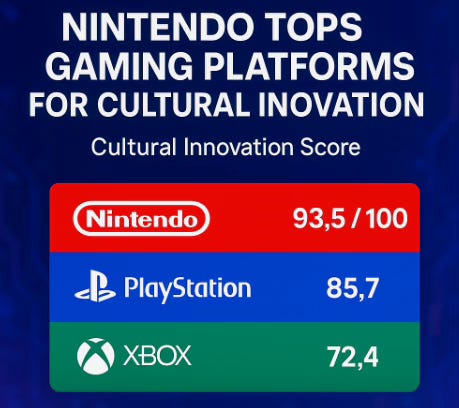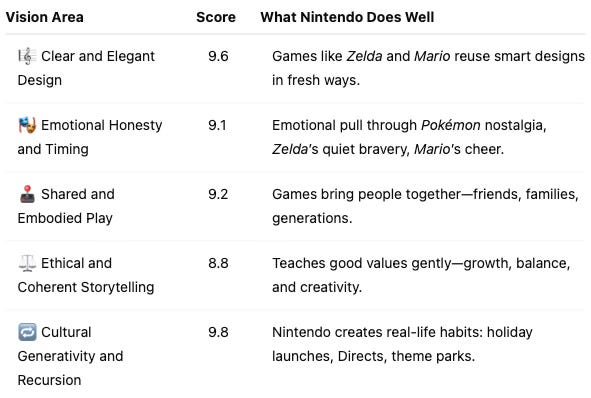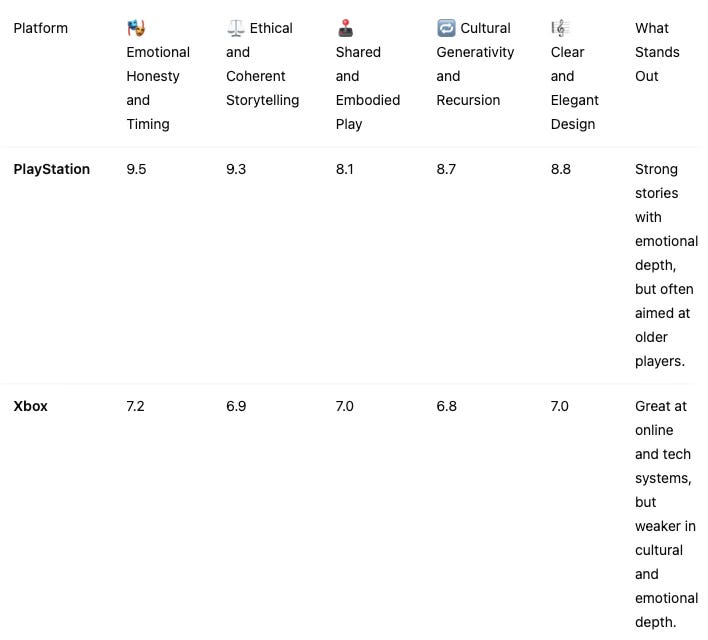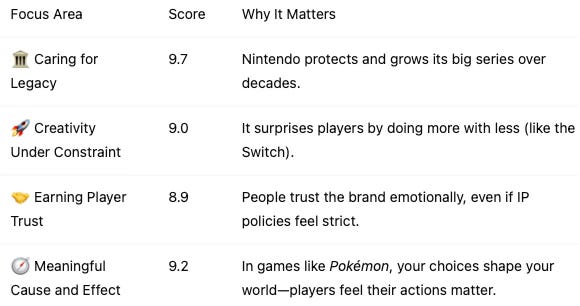MCAI Culture Vision: Nintendo Tops Gaming Platforms for Cultural Innovation
How Nintendo Designs for Memory, Meaning, and Multi-Generational Play
I. Introduction
Nintendo stands apart in the gaming industry—not just as a console maker, but as a storyteller that shapes culture. While PlayStation focuses on movie-like storytelling and Xbox builds powerful tech systems, Nintendo does something different: it creates games that become lifelong memories. Through smart design, emotional connection, and games for all ages like Super Mario and Pokemon, Nintendo has built trust and meaning across generations. This paper uses the MindCast AI LLC Cultural Vision framework to explore how cultural innovation—not just hardware—can shape a platform's long-term impact.
II. What Is Cultural Innovation?
Cultural innovation is what separates a trend from a tradition. It’s how games become part of personal histories and shared experiences, not just entertainment. This section explains the framework used to evaluate cultural impact across five key areas. Each area captures a different part of how games express meaning and build long-term influence.
Cultural innovation means creating something that sticks in people’s lives, that is passed down and remembered. The MCAI system looks at five key areas to measure this:
| 🎼 Clear and Elegant Design | How clearly and beautifully a game is designed. Repeating patterns that stay fresh. | | 🎭 Emotional Honesty and Timing | How honest and well-timed the emotional experiences are. | | 🕹️ Shared and Embodied Play | How well a game supports shared play and real connection between people. | | ⚖️ Ethical and Coherent Storytelling | Whether the game’s world and actions feel ethically sound and make sense over time. | | 🔁 Cultural Generativity and Recursion | Whether the game creates traditions, memories, and cultural habits that last. |
This framework helps translate abstract ideas—like emotional connection or social rituals—into measurable insights. The categories introduced above shape how we evaluate not just Nintendo, but its key competitors. However, it's important to note this framework is designed to be descriptive, not predictive. The real challenge is testing whether these cultural traits align with outcomes beyond storytelling.
Other useful lenses:
| 🏛️ Caring for Legacy | Does the company care for its creations over time? | | 🚀 Creativity Under Constraint | Can it do more with less? Can it surprise us? | | 🤝 Earning Player Trust | Do people feel safe and valued when engaging with it? | | 🧭 Meaningful Cause and Effect | Do actions in the game lead to meaningful results? |
III. Nintendo's Cultural Strengths
Nintendo’s strengths become clear when measured against the Cultural Vision framework. This section shows how its games balance clarity, emotional depth, social bonding, ethical design, and long-lasting traditions. These traits are not accidental—they're the result of deeply intentional creative choices. The table below explains how Nintendo performs in each area and why it matters.
As the table shows, Nintendo scores near the top in every category. However, this analysis must be interpreted carefully: high scores do not automatically explain market dominance. Instead, they show how Nintendo’s creative direction aligns with sustained emotional connection. These results highlight a deep investment in long-term identity, but do not imply universal superiority.
IV. How It Compares
Nintendo isn’t operating in a vacuum—its competitors bring their own strengths. PlayStation is known for cinematic storytelling, while Xbox leans on online infrastructure and services. But when it comes to cultural depth, they fall short of Nintendo’s holistic resonance. This section puts their performances side by side for direct comparison.
This table reflects chosen dimensions of cultural engagement, but doesn't account for business model diversity or global strategic differences. Xbox’s strength in cloud services and Game Pass innovation, and PlayStation’s dominance in cinematic exclusives, deserve recognition. Nintendo’s cultural edge is real—but only within the defined terms of this framework. A fuller market analysis would also evaluate financial performance, innovation ecosystems, and platform reach.
Console Sales in 2024 The data below shows console sales by market share in 2024. While PlayStation leads in hardware units, it does not top the charts in long-term cultural impact. Xbox sits in the middle for infrastructure but lacks narrative depth. Nintendo may be third in units sold, but it leads where it counts—cultural loyalty and emotional reach.
These scores reflect a different kind of leadership—based on emotional connection, design clarity, and cultural stickiness rather than console units sold. Nintendo's score of 93.5 indicates its dominance in fostering shared traditions, intergenerational appeal, and symbolic trust. PlayStation performs well due to its narrative and emotional depth, while Xbox lags due to weaker cultural resonance despite its strong tech infrastructure. Importantly, these scores are descriptive indicators of cultural value—not predictors of market performance or profitability.
Cultural scores help us understand brand identity and emotional continuity, but do not explain causality in business performance. The assumption that higher cultural value guarantees long-term profitability requires further testing and industry-wide benchmarking.
V. Why Nintendo Will Keep Winning
Cultural leadership isn’t just about the present—it’s about sustaining relevance over time. This section explores the deeper reasons why Nintendo’s momentum is built to last. It includes long-term care for its iconic series, inventive design despite limitations, and the emotional trust players place in the brand. These qualities offer durable advantages that go beyond technical specs or short-term trends.
As shown in the table, Nintendo’s advantages span not just nostalgia but strategic foresight. It has built an enduring relationship with players by consistently delivering emotionally rich, meaningful content across generations. The company also innovates by focusing on gameplay joy rather than tech arms races. These factors create a resilient edge in a market often distracted by flashier metrics, as visualized in the table above.
VI. Conclusion
Nintendo’s consistent cultural impact isn’t accidental—it’s a result of smart design, emotional trust, and multi-generational connection. This final section ties together the findings from the Cultural Vision framework and supporting scores. The result is a platform that doesn’t just entertain, but enriches. These qualities ensure Nintendo’s leadership in a landscape that is constantly evolving.
However, readers should be cautious about assuming cultural leadership always translates into financial dominance. Nintendo’s approach reflects one viable path, not the only one. Other platforms prioritize ecosystem expansion or cinematic immersion with equal legitimacy. Cultural innovation matters—but it is just one part of a larger equation in shaping gaming’s future.
Prepared by Noel Le, Architect of MindCast AI LLC. Noel holds a background in law and economics.







